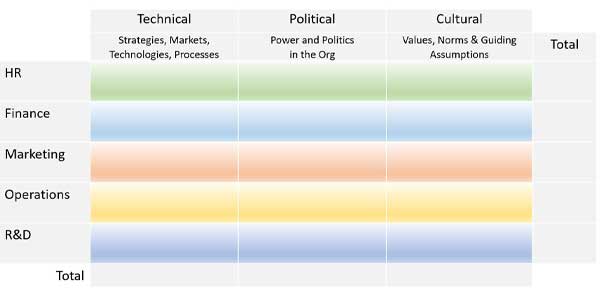
by Rick Stomphorst
During the interview process, virtually every candidate asks about the culture of the prospective new company, which is rarely known, and is thereby given little weight when deciding the merits of a new job. People wrongly believe they can adapt to virtually any culture, or can impact the culture to suit them (there is some truth to the later, if you’re joining a small company).
What is culture then? How do you determine culture? One method is by learning the symbols, norms and assumptions.
Symbols are the logos, dress code and décor.
Norms are shared social, often un-written, rules. What behaviour is tolerated, discouraged or encouraged? How do people interact with or treat each other or other departments? Are there shared values (e.g. trust) or routines (e.g. meeting minutes)?
Assumptions are undocumented rules or truths within an organization. “We always do X this way”.
Will your symbols, norms and assumptions align with your new company’s or create friction? You either have to adapt or alter your cultural norms or identify which are helping or hindering your performance.
In your on-boarding plan, ask your new colleagues why and why not they enjoy working there. The answer is often the answer to the culture question.
<< Previous Blog | |<< Beginning

by Rick Stomphorst
How well you perform at your new role will largely be affected by how well you interface with new manager(s), colleagues, staff, stakeholders, decision makers, influencers, clients and certainly others. If you don’t create good alliances with this group of people, projects you work on will be at risk, and resultingly so will your on-boarding.
For each project or exercise ask yourself which decision makers are essential to move forward.
Decision makers are in turn influenced by the opinion of their trusted network for advice and counsel. This network, and we all have them, is essentially a shadow organization. Each of the individuals in trusted network brings influence due to either their expertise, control of information, connections to others, assess to resources (money and people), and/or loyalty. Any of these people can positively impact your efforts or derail them. You need to identify who these individuals are.
Ask your new manager for list of key people outside your group whom she thinks you should connect with (by now you should have met with key people within your group). Using the strategy in an previous blog, strive to ask these people the same set of questions.
Detractors from your efforts or projects usually caused by to one or more of these reasons:
- Desire to maintain the status quo.
- Fear of looking incompetent. E.g. adopting new technology they don’t understand.
- Threatens their power. E.g. Removing their control, recognition, or usefulness to the business.
- Negative consequence to their allies. E.g. Your changes may negatively impact people or business units they care about or feel responsible for.
The above may not be adversaries if you can just manage or mitigate any impact. Think hard about how to make it hard for them to say no. Avoid asking them to make a decision that will involve any of the above impacts.
Find alignment with key players where you projects/work can mesh or leverage each other.
Build alliances that will help you advance your work. You need Technical advisors, Cultural advisors and Political advisors, and a mix of internal and external advisors. You may have been hired to make changes that may regrettably, but unavoidably, impact others, however, for the good of the overall business. If so, you will need your own network soon.
Remember that in today’s business climate, no senior-level manager (perhaps you) is hired to maintain the status-quo. They (you?) are hired to make impactful changes to the business.
<< Previous Blog | Next Blog >>

by Rick Stomphorst
The 90 day point at your new job is a milestone. You’re at the “end of the beginning” of your new job. At this point the expectations of your manager, your new colleagues and staff (if applicable) will be heightened. Are you progressing or failing? How do you know?
A good question to ask during your interview is After 90 days, how will you know I’m doing a good job? While you will revisit their answer during your first 90 days, that answer forms the 90 day milestone where you will assess your success to-date.
In addition to the 90 day question, an Early Win, often not found in their 90-day answer, can go a long way in building your credibility, good relationships and momentum to carry you beyond the 90 day milestone.
Early Win
One technique is to identify potential early wins. You may uncover these during your learning phase. When a potential early win is discovered, ensure your new manager, and to an extent, your peers and staff are on the same page. Your first win needs predetermined measurable success criteria and short-term milestone successes.
Each early-win-project contains the following phases:
- Learning
- Designing the Change
- Rallying support
- Implementation
- Learning from change
The Best Early Win
The best wins are tangible improvements saving money, time or resources. Ambitious (e.g.) fundamental changes in strategy, structure, processes or skill sets, should be avoided as there is potential for the company’s self-defense mechanisms kicking-in as discussed in the On-boarding Risks. It goes without saying to avoid early losses. It is exceedingly difficult to recover from an early loss.
The priorities for an early win should balance the learned needs of the company and your career goals, which you found were in alignment during the interview phase.
Sometimes an early win identifies itself as a ticking time bomb. As you represent a fresh set of eyes, you are often the best suited to identify these. Your learning plan is comparable to being a detective, something unique to the company. Different parts of the company may have different components of the puzzle and you may be the only person equipped to assemble the pieces. Simply by identifying a time bomb may equate to an early win.
Where to find Early Wins
| Likely source |
Internal politics, departments not communicating effectively creating opportune conditions for problems. Fortunately for you, you have no political baggage and therefore are unbiased. |
| Probable source |
Internal capabilities or lack thereof. For example, problems or gaps with skill sets, processes or product quality issues or dissatisfied customers. |
| Potential source |
Changing market conditions, new competitors or a failing strategy. Regarding competition, is your product overpriced, inferior, or a new competitive product. |
| Unlikely source |
New government regulations, economic conditions, health and safety aspects of your product. |
When / if you identify a problem, you must take action:
- Generate awareness and conversation of the problem.
- Figure it out. Tactically what should the business do to avoid the problem?
- Big picture. Strategically what should the business do to avoid this problem in the future?
- Plan. Have a plan to address the problem
- Support. Ensure others are on-board to address the problem.
A Word about People Behavioral Changes
During your on-boarding you’re identifying behavioral traits of the people. If you’re in a management position, you need to decide if these behaviors are beneficial to creating or sustaining a high-performance team or not. Look for these positive characteristics in people:
| Focus |
Do they have priorities or too many priorities? Having too many priorities is demoralizing as they know they can’t all be achieved. |
| Discipline |
Do they attain a consistent level of performance? |
| Innovation |
Are improvements consistently sought after? Are we pushing the envelope? |
| Teamwork |
Is the team playing nice together? Are people hording knowledge? Are individuals more apt to recognize group achievements over self? |
| Sense of Urgency |
Are customer needs being ignored in favor maintaining the safe status quo? |
During your first win project, you should begin to instill new methods of behaviours in the business (if warranted).
Closing
From your first day you’re being accessed and impressions are being formulated. If you’re not making positive progress, opinions will be negative.
<< Previous Blog | Next Blog in Series >>

by Rick Stomphorst
This blog touches on the unanticipated findings during your on-boarding process.
You understood your new company to be mature yet you’re discovering it to be very immature. You’ve discovered there are few documented processes, everyone seems to be fighting fires and there isn’t a HR policy manual. Or vise versa, everything has a documented procedure and there is no room for innovation.
You have a fixed amount of time to investigate a new employer during the interview period. Performing an exhaustive research to make an 100% informed decision about the new employer is impossible. For example, during a merger or acquisition, professionals using a tried & true process to research the to-be-acquired company, and they still can’t find everything. You research the company in the time allotted and to the best of your abilities.
STARS
Businesses exist in one of four phases of in their lifespan, which Author Michael Watkins refers to the STARS model:
- Startup
- Turnarounds
- Accelerated Growth
- Realignment
- Sustaining success
Startup – The company is trying to launch a new business, product or service. Limited financial resources, employees are usually less focused on key issues, there is ongoing excited confusion, your assembling startup’s capabilities, corporate memory is virtually non-existent – residing with a few key resources – the company’s primary goal is often fiscal survival. You must channel the excited confusion into a productive direction. You need measurable goals and create value, often requiring tough calls. By definition, startups are on the offensive requiring hunter type management.
Turnaround – Stakeholders know what the problems are, but not what to do about it. For example, the product is at end-of-life with no replacement in sight or a competitor has been relentlessly eating away at your business greatly eroding the financial viability of the business, but at least the team recognizes the consequences and they are hungry for hope. At any given time, between 20 and 30 percent of all companies are in need of a turnaround (J. Murphy 1986). Staff may be demoralized. You need to teach people the need for change and about the problems. Your business, process or product takes on a defensive strategy. You have one goal, which is to get to a defendable line, meaning you’ll have to make tough calls. Again, hunter type management is required.
Accelerated Growth – Managing a rapidly growing business. Putting processes and systems in place to enable the business to scale. The growth helps motivate people who will in-turn stretch themselves to achieve objectives.
Realignment – People are unwilling to see the forest for the trees, they are in denial. The challenge is dealing with ingrained cultural norms and convincing employees that change is necessary. You will still likely to have strong people, products or technologies. You have to create a sense of urgency. A farmer management type is needed here. Hunter type management types don’t work well here.
Sustaining Success – This is the plateau companies strive for. Complacency sets in. Innovation slows. You have to create a new challenge to fend off complacency and find new areas to succeed or grow. A farmer management type is needed here to take the company to the next level.
Multiple Phases
It’s not uncommon to find a company existing in multiple phases of a business’s life cycle. Various departments, products or systems/processes may each exist in a different phase. For example
- A Sustaining Success firm could be launching a new product line, which falls into a Startup category,
- A company may have just been acquired by a firm in Turnaround.
You need to identify where each key department, product, or process exists in the STARS model. This will enable you to procedurally tackle the unique issues in each category with a common framework unique to that category.
Take some time to categorize your new situation as this will aid in strategizing your approach to each. Categorize the departments, processes and products as you learn about them.
There is much business literature on the various phases of businesses. If you find your business / department / process / product entrenched in any particular state, suggest learning more about that one specific phase.
<< Previous Blog | Next Blog in Series >>

by Rick Stomphorst
It’s human nature to gravitate towards areas that interest us most. These areas become our preferences. However, these preferences, as it relates to problem solving, may become a blind spot and harm you during on-boarding.
Table 1-2 below, from Watkins’ The First 90 Days, is a simple method for assessing your preferences for different kinds of business problems, for identifying your blind spots. Complete this table by assessing your intrinsic interest in solving problems in the domain in question, not by assessing your skills or experience.

Table 1-2
When complete, transpose the values in these 15 cells into the 15 cells in Table 1-3 below, (again from Watkins’ The First 90 Days). E.g. Green Row1-Column1 to Green Row1-Column1.

Table 1-3
Lastly, calculate the totals. If one column total is noticeably lower than the others, this represents a potential blind spot for you.
The row totals represent your preference for various business functions. For example, if Marketing is low but represents a success criteria for you, you need to be cognizant of that develop a mitigation strategy.
Most people are unable to articulate, or don’t really know their preferences. This method provides you with the means to measure what you enjoy and don’t enjoy working on.
<< Previous Blog | Next Blog >>







